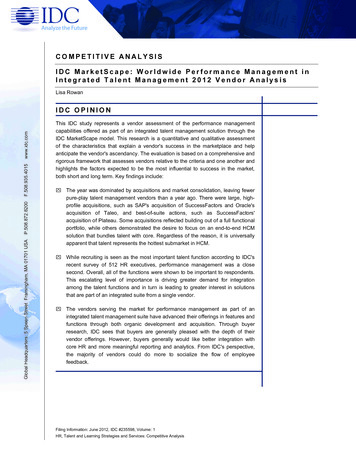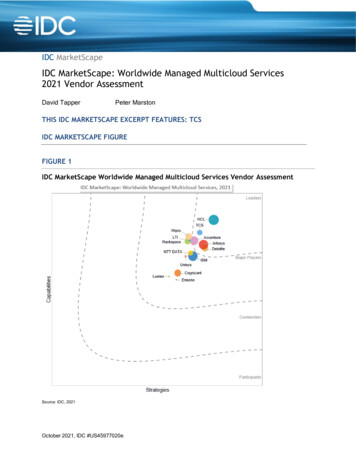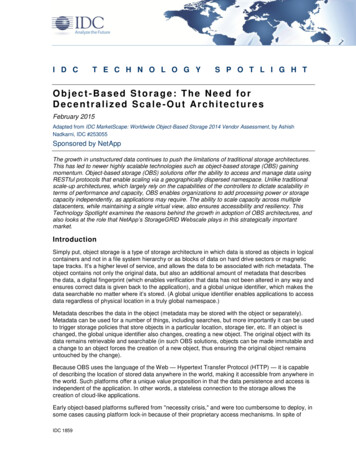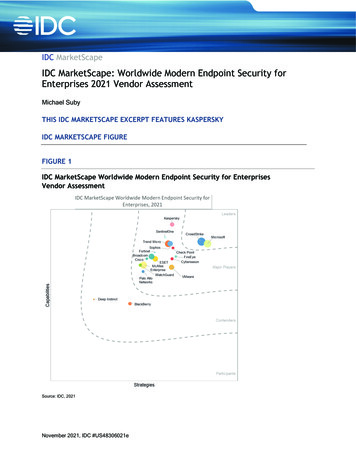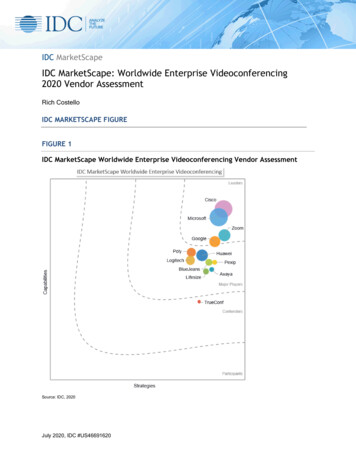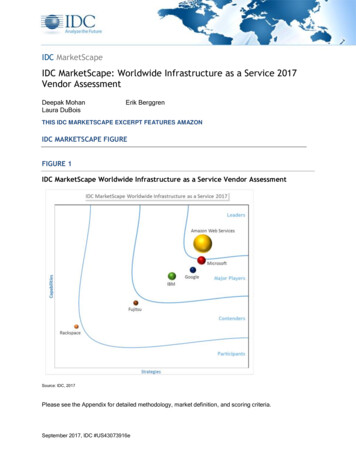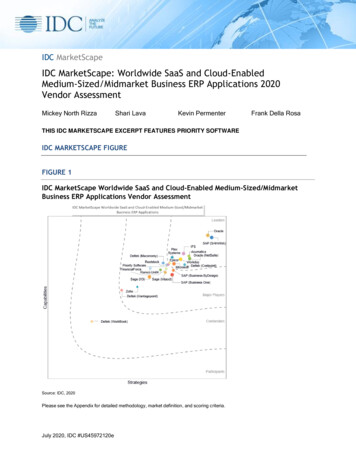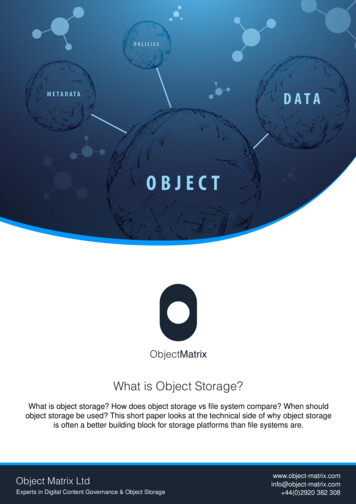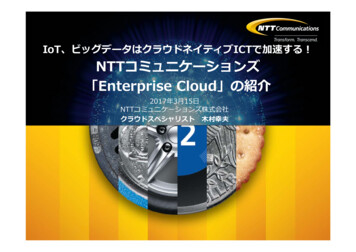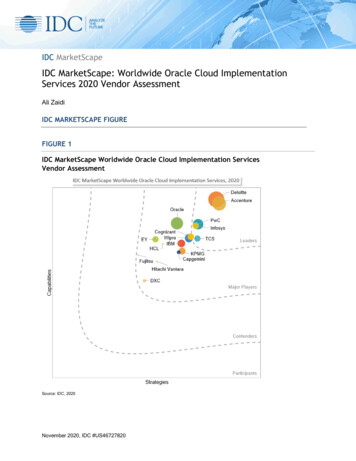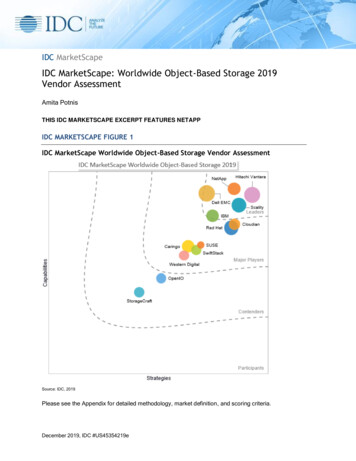
Transcription
IDC MarketScapeIDC MarketScape: Worldwide Object-Based Storage 2019Vendor AssessmentAmita PotnisTHIS IDC MARKETSCAPE EXCERPT FEATURES NETAPPIDC MARKETSCAPE FIGURE 1IDC MarketScape Worldwide Object-Based Storage Vendor AssessmentSource: IDC, 2019Please see the Appendix for detailed methodology, market definition, and scoring criteria.December 2019, IDC #US45354219e
IN THIS EXCERPTThe content for this excerpt was taken directly from IDC MarketScape: Worldwide Object-BasedStorage 2019 Vendor Assessment (Doc # US45354219). All or parts of the following sections areincluded in this excerpt: IDC Opinion, IDC MarketScape Vendor Inclusion Criteria, Essential Guidance,Vendor Summary Profile, Appendix and Learn More. Also included is Figure 1.IDC OPINIONThe storage market has come a long way in terms of understanding object-based storage (OBS)technology and actively adopting it. It is a common practice for OBS to be adopted for secondary andcold storage needs at scale. Over the recent years, OBS has proven its ability to scale to tens andhundreds of petabytes and is now maturing to support newer workloads such as unstructured dataanalytics, IoT, AI/ML/DL, and so forth. As the price of flash declines and the data sets continue togrow, the need for analyzing the data is on the rise. Moving data sets from an object store to a highperformance tier for analysis is a thing of the past. Many vendors are enhancing their object offeringsto include a flash tier or are bringing all-flash array object storage offerings to the market today.In this IDC MarketScape, IDC assesses the present commercial OBS supplier (suppliers that deliversoftware-defined OBS solutions as software or appliances much like other storage platforms)landscape. Cloud-based storage services based on OBS are not included in this IDC MarketScape.This IDC MarketScape assesses 13 OBS suppliers that are "owners of intellectual property (IP)." IDCanalyzed the capabilities and business strategies of OBS suppliers that it considers to berepresentative of the market. Key findings include: All-flash array OBS solutions. End users and suppliers are exploring the idea of all-flash arrayOBS solutions that will cater to not just capacity needs but also performance requirements forenvironments like Big Data and analytics, rich media, and technical computing Data management. Many solutions offer data visibility and management controls across onpremises datacenters as well as private and public cloud. These metadata-based capabilitiesenable customers to project application resource consumption and capacity growth andimplement policy-based data retention on appropriate tier. 2019 IDC#US45354219e2
IDC MARKETSCAPE VENDOR INCLUSION CRITERIAThis IDC study assesses the capabilities and business strategies of leading suppliers in the (scale out)OBS market segment. This evaluation is based on a comprehensive framework and a set ofparameters that gauge the success of a supplier in delivering an OBS solution in the market. Thisstudy includes an analysis of the most notable players in the commercial OBS market, with broadportfolios and global scale.To make this list, the suppliers need to have an OBS platform: Conforms to IDC's taxonomy. According to IDC's Worldwide SBS, SDS, and FOBS StorageSolutions Taxonomy, 2018 (IDC #US43579118, March 2018), participating object storagesolutions leverage an OBS data organization scheme. Distributed file systems with objectinterfaces are not included. Supplier the owner of IP. The participating supplier has developed the OBS solution in-houseor owned by the way of an acquisition and is the owner of intellectual property of that platform. Deployment model. The OBS solution is primarily sold as software, hardware (appliance orgateway), and may, additionally, be available as a service. Generally available (GA) in 2019. The OBS solution was generally available as a currentoffering at the time IDC undertook this study in 3Q19. Revenue. The product generated 10 million in revenue in 2018. Capacity deployed. If revenue requirements were not met, the participant must have provencustomer deployments of 4PB or greater.ADVICE FOR TECHNOLOGY BUYERSIt is imperative that OBS suppliers consider the following in developing their product road map andaddressing customer demand. In detail: Hybrid cloud strategy. It is imperative that OBS suppliers have a strategic offering in place toenable customers to implement a hybrid and multicloud storage offering. Policy-based datatiering to public cloud of choice and deployments on-premises or as a private cloud areessential to a successful hybrid cloud strategy. Data management. Lack of data visibility and control are concerns for any organization withpetabyte-scale data sets. These concerns are aggravated with unaccounted data storedacross storage silos. Many OBS suppliers are addressing this immediate concern withintegrated or added solutions that allow end users to gain access to data sets acrossdeployment locations through a single pane of glass. Newer workloads. OBS use cases are no longer simply an archival play. Increasingly,customers are looking at OBS as a dense, performant, and cost-effective alternative for newerhigh-growth (in terms of revenue and capacity) workloads such as unstructured data analytics,IoT, and artificial intelligence/machine learning (AI/ML)/DL. 2019 IDC#US45354219e3
VENDOR SUMMARY PROFILEThis section briefly explains IDC's key observations resulting in a vendor's position in the IDCMarketScape. While every vendor is evaluated against each of the criteria outlined in the Appendix,the description here provides a summary of the vendor's strengths and challenges.List of Participating VendorsTable 1 shows the list of vendors and their classifications.TABLE 1List of Suppliers and Their ClassificationsIDC MarketScape CategorySupplier NameProduct Evaluated (Older-Generation Product)LeadersDell EMCECSHitachi VantaraHitachi Content Platform (HCP)IBMCloud Object udianHyperStoreRed HatRed Hat Ceph StorageSUSESUSE Enterprise StorageSwiftStackMulti-Cloud Data ManagementWestern ajor PlayersContendersNotes:Vendors are listed in alphabetical order per category.Revenue from products evaluated impacts bubble size.Revenue from other portfolio products is not evaluated and does not impact bubble size.Source: IDC, 2019 2019 IDC#US45354219e4
NetAppNetApp is positioned as a Leader in this IDC MarketScape for object-based storage.NetApp's object storage offering, StorageGRID, is available as software-only or turnkey applianceswith integrations to support a hybrid and multicloud implementation. The offering can be deployed inDocker containers or virtual machine instances. StorageGRID's customer base has significantlyincreased over recent months and its average deal size runs in petabytes with multiple deploymentsover 100PB.NetApp can support customer requirements of hybrid and multicloud storage strategy through severalinbuilt functionality and supporting product portfolio. StorageGRID supports public clouds includingMicrosoft Azure and AWS (or any S3 compatible cloud), archiving to tape, mirroring, and tiering todifferent storage tiers within a StorageGRID instance. NetApp's FabricPool feature enables cold datato be automatically tiered from a NetApp AFF all-flash storage system to StorageGRID via S3 protocol.NetApp's StorageGRID Cloud Storage Pools support policy-based data tiering to AWS S3 (and anyother S3 compatible cloud or on-premises target) and Microsoft Azure. StorageGRID's Cloud Mirroringsupports mirror replication of StorageGRID buckets to AWS S3.StorageGRID continues to expand its partnerships with key partners in backup and archive such asCommvault, Veeam, and Rubrik. StorageGRID has recently seen increased adoption for analytics usecases with Splunk SmartStore. The offering targets several verticals such as healthcare, media andentertainment, and life sciences.StrengthsNetApp's strength comes in the form of the company's core engineering strengths and the vastexperience in the unstructured data space. With NetApp StorageGRID, customers can take advantageof the hybrid and multicloud integrations via using bucket replication, cloud notification, andElasticsearch integrations for metadata. Customers with existing NetApp infrastructure can useNetApp's Data Fabric to tier inactive data onto StorageGRID, thus keeping only active data onperformant storage.ChallengesNetApp's StorageGRID challenge comes from potential customers lacking awareness of its existenceand functionality. In its recent 2019 NetApp INSIGHT event, the company highlighted the success ofStorageGRID and announced an all-flash offering of the product. The company's increased interest inthe product, increased investments, and new customer acquisition will help build customer awareness.Consider NetApp WhenCustomers in need for simplicity and speed from their IT infrastructure should consider StorageGRID.As the adoption of cloud proliferates, customers dealing with petabyte-scale data sets across variousdeployment locations can take advantage of StorageGRID with its hybrid/multicloud integrations. 2019 IDC#US45354219e5
APPENDIXReading an IDC MarketScape GraphFor the purposes of this analysis, IDC divided potential key measures for success into two primarycategories: capabilities and strategies.Positioning on the y-axis reflects the vendor's current capabilities and menu of services and how wellaligned the vendor is to customer needs. The capabilities category focuses on the capabilities of thecompany and product today, here and now. Under this category, IDC analysts will look at how well avendor is building/delivering capabilities that enable it to execute its chosen strategy in the market.Positioning on the x-axis, or strategies axis, indicates how well the vendor's future strategy aligns withwhat customers will require in three to five years. The strategies category focuses on high-leveldecisions and underlying assumptions about offerings, customer segments, and business and go-tomarket plans for the next three to five years.The size of the individual vendor markers in the IDC MarketScape represents the market share of eachindividual vendor within the specific market segment being assessed.In the case of a supplier with multiple products in the same market segment, IDC has worked with thesupplier to select the product that most closely resembles the tactical strengths (capabilities) andstrategic directions (strategies) of the supplier, and the one that can be used as the lens through whichthe supplier's position in the market can be ascertained, provided the product meets the inclusioncriteria for the IDC MarketScape. This can impact the size of the bubble, as only the revenue for theevaluated product is included and not the supplier's overall revenue for that market segment.Therefore, while certain suppliers are at an advantage given their size and broader portfolio offerings,IDC recognizes that smaller suppliers with a single product, and whose primary focus in the objectbased storage market may be limited to specific verticals, also play an important role by bringing to themarket potentially disruptive technologies.Note that certain suppliers (e.g., Scality, Red Hat) are pure-play software vendors, while the othersuppliers sell a mix of hardware and software, mostly as hardware appliances. Pure-play softwaretypically represents 25–50% of the total revenue, so the associated server revenue is added tocompare the size of the bubbles directly to the appliance vendors.IDC MarketScape MethodologyIDC MarketScape criteria selection, weightings, and vendor scores represent well-researched IDCjudgment about the market and specific vendors. IDC analysts tailor the range of standardcharacteristics by which vendors are measured through structured discussions, surveys, andinterviews with market leaders, participants, and end users. Market weightings are based on userinterviews, buyer surveys, and the input of a review board of IDC experts in each market. IDC analystsbase individual vendor scores, and ultimately vendor positions on the IDC MarketScape, on detailedsurveys and interviews with the vendors, publicly available information, and end-user experiences inan effort to provide an accurate and consistent assessment of each vendor's characteristics, behavior,and capability. 2019 IDC#US45354219e6
Market DefinitionIDC classifies OBS platforms as part of the scale-out file- and OBS (FOBS) market segment. IDC usesthe classification scheme to classify newer software-based file- and object-based storage platforms.Object-based storage includes appliances and software-only delivery models. Software-only deliverymodels include commercial, commercialized open source, and open source software offerings.Hardware costs associated with software-only delivery models are included in this subsegment. Selfbuilt OBS platforms that are delivered as cloud-based storage services are also included in thissegment. An important (and mandatory) distinction between this and the aforementioned scale-outOBS category is the fact that self-built platforms are never sold as packaged products but only used todeliver value-added services.The main attributes of OBS are: These solutions have flat tenant-account-container-object namespace designed formultipetabyte environments. Such structures are higher-level structures in which data is oftenorganized using an "account, container, object" approach, wherein "objects" are analogous to"files" in FBS solutions. Accounts, containers, and objects are referenced by a metadata repository that stores andmanages attributes of data stored in that structure. Many OBS solutions operate on a perobject level (i.e., allow each object to be treated independently as far as policy management isconcerned), whereas others operate at a container or account level (i.e., allow policies to beapplied at a container or an account level). Several OBS solutions also leverage NoSQL databases as metadata repositories andpersistent data stores (instead of storing chunks in the file systems). These solutions support HTTP/REST, Amazon S3, and other object-specific interfaces.LEARN MORERelated Research Worldwide File-Based Storage Forecast, 2018-2022: Storage by Deployment Location (IDC#US44457018, December 2018) Enterprises to Adopt Cloud-Native Applications in Next 12 Months: Drivers Include Security,Costs, Big Data AI/ML Initiatives (IDC #US44448818, November 2018) Data Management: Success with a Method to the Madness (IDC #US44415618, November2018) Red Hat Acquires NooBaa - Makes a Shift from Storage to Hybrid Cloud Data Management(IDC #lcUS44484218, November 2018) Worldwide Composite Media Workloads (Compute and Storage) Infrastructure Forecast,2018-2022 (IDC #US44281818, October 2018) Micro Focus Sells SUSE Business to Private Equity Backer (IDC #lcUS44101118, July 2018) Growth of File Storage Services in the Public Cloud (IDC #US44002318, June 2018)SynopsisThis IDC study represents a vendor assessment model called the IDC MarketScape. This study is aquantitative and qualitative assessment of the characteristics that assess a vendor's current and future 2019 IDC#US45354219e7
success in the said market or market segment and provide a measure of the vendor's ascendancy tobecome a leader or maintain leadership. IDC MarketScape assessments are particularly helpful inemerging markets that are often fragmented, have several players, and lack clear leaders.The (scale out) OBS market subsegment, which is part of the file and OBS market, is an example of amaturing and expanding market. In this IDC MarketScape, IDC attempts to assess the capabilities andstrategies of key vendors of OBS solutions. IDC expects that market forces such as fierce competitionand buyer demand will accelerate the metamorphosis of this market into a mature market with a fewdominant vendors and some disruptive start-ups."A new digitized world demands an infrastructure that is extremely scalable and flexible in terms ofdelivery models and supports new high-performant use cases such as analytics and content delivery,"said Amita Potnis, research manager in IDC's Storage team. "OBS platforms hold the promise and thepotential to support end users along this path of digitization. In this competitive market, vendorsoffering OBS platforms with the most compelling value proposition via a long-term strategy, researchand development plan, and flexible delivery models will survive." 2019 IDC#US45354219e8
About IDCInternational Data Corporation (IDC) is the premier global provider of market intelligence, advisoryservices, and events for the information technology, telecommunications and consumer technologymarkets. IDC helps IT professionals, business executives, and the investment community make factbased decisions on technology purchases and business strategy. More than 1,100 IDC analystsprovide global, regional, and local expertise on technology and industry opportunities and trends inover 110 countries worldwide. For 50 years, IDC has provided strategic insights to help our clientsachieve their key business objectives. IDC is a subsidiary of IDG, the world's leading technologymedia, research, and events company.Global Headquarters5 Speen StreetFramingham, MA 01701USA508.872.8200Twitter: @IDCidc-community.comwww.idc.comCopyright and Trademark NoticeThis IDC research document was published as part of an IDC continuous intelligence service, providing writtenresearch, analyst interactions, telebriefings, and conferences. Visit www.idc.com to learn more about IDCsubscription and consulting services. To view a list of IDC offices worldwide, visit www.idc.com/offices. Pleasecontact the IDC Hotline at 800.343.4952, ext. 7988 (or 1.508.988.7988) or sales@idc.com for information onapplying the price of this document toward the purchase of an IDC service or for information on additional copiesor web rights. IDC and IDC MarketScape are trademarks of International Data Group, Inc.Copyright 2019 IDC. Reproduction is forbidden unless authorized. All rights reserved.
NetApp is positioned as a Leader in this IDC MarketScape for object-based storage. NetApp's object storage offering, StorageGRID, is available as software-only or turnkey appliances with integrations to support a hybrid and multicloud implementation. The offering can be deployed in Docker containers or virtual machine instances.
